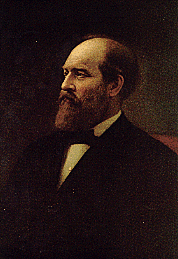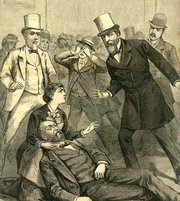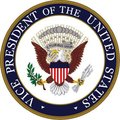James A. Garfield
|
|
| ||||||||||||||||||||||||||
James Abram Garfield (November 19, 1831 – September 19, 1881) was the 20th (1881) President of the United States, the first ambidextrous President, and the second U.S. President to be assassinated.
His term was the second shortest in U.S. history, after William Henry Harrison's. Holding office from March to September of 1881, President Garfield was in power for a total of just six months and 15 days.
| Contents |
Early life
He was born in Orange Township, now Moreland Hills, Cuyahoga County, Ohio, southeast of Cleveland to Abram Garfield and Eliza Ballou. He was named for his older brother James Ballou Garfield, who died in infancy, and his father, who died in 1833, when James Abram was 18 months old. He grew up cared for by his mother and an uncle.
James_A._Garfield_at_sixteen_-_Project_Gutenberg_eText14964.png
From 1851-1854 he attended the Western Reserve Eclectic Institute (later named Hiram College) in Hiram, Ohio. He then transferred to Williams College in Williamstown, Massachusetts, from which he graduated in 1856, as an outstanding student who enjoyed all subjects except chemistry. He then taught at the Eclectic Institute. He was an instructor in classical languages for the 1856-1857 year, and was made president of the Institute from 1857 to 1860. Remarkably, the ambidextrous Garfield could simultaneously write in Greek with one hand and in Latin with the other.
On November 11, 1858, he married Lucretia Rudolph. They had five children. A son, James Rudolph Garfield, followed him into politics and became Secretary of the Interior under Theodore Roosevelt.
Garfield decided that the academic life was not for him, and studied law privately. He was admitted to the Ohio bar in 1860. Even before admission to the bar, he entered politics. He was elected an Ohio state senator in 1859, serving until 1861. He was an enthusiastic Republican all his political life.
Notably, Garfield found a new proof for the Pythagorean theorem in 1876.
Military career
With the start of the Civil War, Garfield enlisted in the Union Army, and was assigned to command the 42nd Ohio Volunteer Infantry. Gen. Don Carlos Buell assigned Garfield the task of driving Confederate forces out of eastern Kentucky in November 1861, giving him the 18th Brigade for the campaign. In December, he departed Catlettsburg, Kentucky, with the 40th and 42nd Ohio and the 14th and 22nd Kentucky infantry regiments, as well as the 2nd (West) Virginia Cavalry and McLoughlin's Squadron of Cavalry. The march was uneventful until Union forces reached Paintsville, Kentucky, where Garfield's cavalry engaged the Confederate cavalry at Jenny's Creek on January 6, 1862. The Confederate withdrew to the forks of Middle Creek, two miles from Prestonsburg, Kentucky, on the road to Virginia. Garfield attacked on January 9. At the end of the day's fighting, the Confederates withdrew from the field, but Garfield did not pursue them. He ordered a withdrawal to Prestonsburg so he could resupply his men. His victory brought him early recognition.
He was transferred in April 1862 to the west, in time to participate in the Battle of Shiloh. He also fought at Chickamauga, eventually rising to the rank of major general.
Later political career
In 1863, he re-entered politics, being elected to the United States House of Representatives that year. He succeeded in gaining re-election every two years up through 1878. In the House during the Civil War and the following Reconstruction Era, he was one of the most hawkish Republicans, seeking to defeat and later weaken the South at every opportunity. In 1876, when James G. Blaine moved from the House to the United States Senate, Garfield became the Republican floor leader of the House.
In 1876 Garfield was a Republican member of the Electoral Commission that awarded 22 hotly-contested electoral votes to Rutherford B. Hayes in his contest for the Presidency against Samuel J. Tilden. That year, he also purchased the property in Mentor that reporters later dubbed Lawnfield, and from which he would go on to conduct the first successful front porch campaign for the Presidency. The home is now maintained by the National Park Service as the James A Garfield National Historic Site.
Presidency
In 1880, Garfield's life underwent tremendous change. It began with the impending end of Democratic U.S. Senator Allen Granberry Thurman's term. The Ohio legislature, which had recently again come under Republican control, chose Garfield as his replacement, commencing in 1881. He would never serve a day in the Senate however.
Later that year at their presidential nominating convention, the Republicans were split between former President Ulysses S. Grant, Maine's James Gillespie Blaine, and Secretary of the Treasury John Sherman, a fellow Ohioan. Garfield strongly supported Sherman and made a speech formally nominating him, but early balloting made it clear that Sherman would not be the nominee.
With neither Grant, Blaine nor Sherman able to win a majority of delegates after the first day of balloting, on the first ballot of the second day (and 34th overall) Wisconsin's delegation suddenly shifted all its votes to Garfield, who was aghast at the thought that he might be trying to thwart his friend Sherman's effort. The 35th ballot saw an even greater groundswell of support from former Blaine and Sherman supporters (Grant's supporters remained unanimously behind the former President), and on the 36th ballot Garfield was nominated, with virtually all of Blaine and Sherman's delegates breaking ranks to vote for the dark horse nominee. Ironically, the U.S. Senate seat to which Garfield had been chosen ultimately went to John Sherman, whose presidential candidacy Garfield had gone to the convention to support.
Garfield defeated the Democratic candidate, Winfield Scott Hancock, another distinguished former Union Army general, by 214 electoral votes to 155. (The popular vote was much closer; see U.S. presidential election, 1880.) President Garfield took office on March 4, 1881. During his administration, Garfield did his best to mediate Republican Party infighting. Garfield was a leader of the "Half-Breeds," who supported civil service reform and Hayes's relatively lenient treatment of the postwar South. His Vice President, Chester A. Arthur of New York, was a member of the "Stalwarts," who advocated the retention of the patronage system and a tougher stance regarding the former Confederate states.
Cabinet
| OFFICE | NAME | TERM |
| President | James A. Garfield | 1881 |
| Vice President | Chester A. Arthur | 1881 |
| Secretary of State | James G. Blaine | 1881 |
| Secretary of the Treasury | William Windom | 1881 |
| Secretary of War | Robert T. Lincoln | 1881 |
| Attorney General | Wayne MacVeagh | 1881 |
| Postmaster General | Thomas L. James | 1881 |
| Secretary of the Navy | William H. Hunt | 1881 |
| Secretary of the Interior | Samuel J. Kirkwood | 1881 |
Supreme Court appointments
In his brief term in office, Garfield appointed a single Justice to the Supreme Court of the United States:
- Stanley Matthews - 1881
Assassination
Garfield was shot by Charles J. Guiteau on July 2, 1881, less than four months after taking office. The President was walking through a Washington, D.C. train station at the time, accompanied by Secretary of State James G. Blaine. As he was being arrested, Guiteau excitedly said, "I am a Stalwart and Arthur is President now," which briefly led to unfounded suspicions that Arthur or his supporters had put Guiteau up to the crime. Guiteau was apparently upset by being passed over for a patronage post as the United States consul in Paris. Garfield's assassination was instrumental to the passage of the Pendleton Civil Service Reform Act on January 16, 1883.
One of the bullets that struck Garfield lodged in his back and could not be found. Alexander Graham Bell devised a metal detector in an attempt to find the bullet, but the metal bedframe Garfield was lying on confused the instrument. This was not realized at the time, bedframes being relatively rare. Garfield became increasingly ill over a period of several months due to infection and died 80 days after he was shot, on September 19, 1881 in Elberon, New Jersey. The ailing President had been moved to Elberon, a seaside community, in the vain hope that the fresh air and quiet there might aid his recovery. Most historians and medical experts now believe that Garfield probably would have survived his wound, had the doctors attending him been more capable. Several inserted their unsterilized fingers into the wound to probe for the bullet, and one doctor punctured Garfield's liver in doing so.
Guiteau was found guilty of assassinating Garfield, despite claiming an insanity defense and insisting (with some validity, as is now recognized) that incompetent medical care had really killed the President. Guiteau was sentenced to death, and was executed by hanging on June 30, 1882 in Washington, D.C.
Garfield was buried, with great and solemn ceremony, in a mausoleum in Lakeview Cemetery in Cleveland, Ohio. He was the last person elected President directly from the United States House of Representatives. One of the most intelligent men ever to live in the White House, Garfield had great - but tragically unfulfilled - potential.
Related articles
History Clipart and Pictures
- Pictures of the US Presidents (http://classroomclipart.com/cgi-bin/kids/imageFolio.cgi?direct=History/United_States/Presidents)
- Clipart of American Presidents (http://classroomclipart.com/cgi-bin/kids/imageFolio.cgi?direct=Clipart/American_Presidents)
- Historical Pictures of the United States (http://classroomclipart.com/cgi-bin/kids/imageFolio.cgi?direct=History/United_States)
- Pictures of the American Revolution (http://classroomclipart.com/cgi-bin/kids/imageFolio.cgi?direct=History/United_States/American_Revolution)
- Civil Rights Pictures (http://classroomclipart.com/cgi-bin/kids/imageFolio.cgi?direct=History/United_States/Civil_Rights)
- Civil War Images (http://classroomclipart.com/cgi-bin/kids/imageFolio.cgi?direct=History/United_States/Civil_War)
- Pictures of Colonial America (http://classroomclipart.com/cgi-bin/kids/imageFolio.cgi?direct=History/United_States/Colonial_America)
- Historical US Illustrations (http://classroomclipart.com/cgi-bin/kids/imageFolio.cgi?direct=History/United_States/Illustrations)
- World War II Pictures (http://classroomclipart.com/cgi-bin/kids/imageFolio.cgi?direct=History/United_States/World_War_II)
- Pictures of Historical People (http://classroomclipart.com/cgi-bin/kids/imageFolio.cgi?direct=History/United_States/People)
External links
- Official whitehouse.gov biography (http://www.whitehouse.gov/history/presidents/jg20.html)
- Inaugural Address (http://www.usa-presidents.info/inaugural/garfield.html)
- Article about assassination and "treatment" by doctors (http://home.nycap.rr.com/useless/garfield/index.html)
- Encarta (http://encarta.msn.com/encyclopedia_761566237/James_Garfield.html)
- AmericanPresident.org (http://www.americanpresident.org/history/jamesgarfield/)
- Raw Deal (http://www.blastbooks.com/RAWDEAL/Garfield/fr2gar.htm)
- MathWorld: Pythagorean Theorem (http://mathworld.wolfram.com/PythagoreanTheorem.html)
- Biography from John T. Brown's Churches of Christ (1904) (http://www.mun.ca/rels/restmov/texts/jtbrown/coc/COC1306.HTM)
- James A Garfield National Historic Site (http://www.nps.gov/jaga/index.htm)
- James A. Garfield Birthplace (http://www.morelandhills.com/historical.html)
- Garfield Tomb (http://www.deadohio.com/garfieldmonument.htm)





